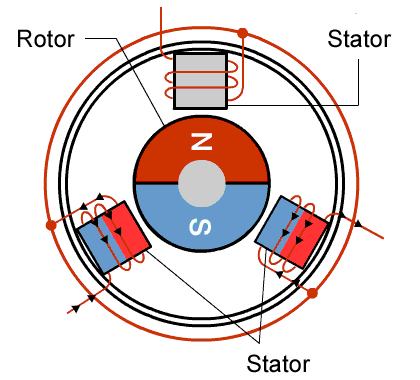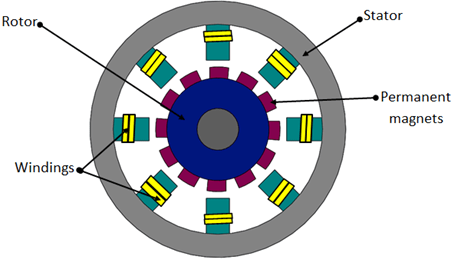Motors and Motor Controller Solutions have served Automotive Industry since time immemorial!
And the ongoing innovations in Motors and the Motor Control Systems have ensured that motors are becoming integral part of diverse set of Automotive Applications.
With efficiency as the motive, Motors and Motor Control Solutions are living up to the expectations of the Automotive Industry (including the Electric Vehicle space)
Interestingly, there are two specific types of Motors that have stood the test of time and have evolved tremendously.
They are popularly known as:
- BLDC Motors – Brushless DC Motors
- PMSM Motors – Permanent Magnet Synchronous Motors.
While BLDC Motors have replaced the Brushed DC Motors, PMSM Motors have come across as a better alternative to AC Induction motor.
When exploring the automotive landscape, the ongoing debate over PMSM vs BLDC motors remains a pivotal aspect of technological advancements.
Both these Motors find application in some of the most innovative automotive applications. For instance, PMSM is now the de-facto Motor deployed in the Drivetrain of Electric Vehicles.
Likewise, applications like Electric Power Steering and HVAC systems function at their best when a BLDC Motor drives them. However, these Motors can be sometimes deployed interchangeably, depending on certain specific use-cases.
Before we delve deeper into the applications, let’s have a little understanding of How PMSM and BLDC Motors work?
In the course, we will also try to discuss about the inherent differences between these two motors.
Handbook Explaining Embitel’s motor control solutions
Download NowHow PMSM and Brushless DC Motors work?
In the dynamic automotive industry, engineers often find themselves weighing the advantages and disadvantages of PMSM vs BLDC motors for various applications.
- Brushless DC (BLDC) Motors –A Brushless DC motor is an upgraded version of a brushed DC Motor. The absence of brushes gives BLDC motors the ability to rotate at high-speed and increased efficiency.

Highlights of a BLDC Motor:
- It has two major parts- a rotor and stator.
- Rotor is the part that moves and has Permanent Magnets as Rotor Magnets.
- Stator is the Stationary component and is made up of Coil Windings.
- Electric Current through the Stator Windings generates a magnetic field which rotates the Permanent Magnet of Rotor.
- By varying the Current flowing through the stator, the speed of the Motor can be varied.
- In most Automotive Applications, the Motor Speed is controlled electronically, using a Brushless DC Motor Controller.
*For in-depth details regarding the Motor Control Systems, please refer to our blog.
Advantages of BLDC Motors:
- Ability to work at higher speed and produce constant torque
- Durability
- Efficiency of almost 85-90%
- Ability to respond to the control mechanisms at high speeds
- No sparks and less noise, as the brushes are absent
- Ease of Motor Control (using BLDC motor controller solutions)
- Ability to self-start
- Gets cooled by conduction and requires no additional cooling mechanism
- Permanent Magnet Synchronous Motor (PMSM)Moving on to the Permanent Magnet Synchronous Motor, it can be seen as an AC counterpart of the Brushless DC motor.PMSM also comprises of a Permanent Magnet as a Rotor and a Stator with a Coil wound over it. The working of PMSM Motor is also quite similar to the BLDC motor.

However, the change lies in the wave form of the Back EMF which is sinusoidal in nature. This is so because the coils are wound on the Stator in a Sinusoidal manner.
It also implies that PMSM requires Alternating Current (Sinusoidal in nature) to achieve the best performance. This type of drive current also reduces the noise produced by the motor. We will discuss the concept of Back EMF in our upcoming blog on Field Oriented Control (FOC).
Advantages of PMSM Motors:
- Higher efficiency than Brushless DC Motors
- No torque ripple when motor is commutated
- Higher torque and better performance
- More reliable and less noisy, than other asynchronous motors
- High performance in both high and low speed of operation
- Low rotor inertia makes it easy to control
- Efficient dissipation of heat
- Reduced size of the motor
PMSM vs BLDC Motors: Understanding the Motor Control mechanism
There is no major difference in motor control systems of BLDC and PMSM Motors; except the nature of the Drive Current and the detection of the Rotor Position.
While we have discussed the drive-current required for both the motors, let’s now talk about the importance of rotor position detection.
The right time to switching on the Motor Phase Current (motor commutation) is important in order to assess the correct amount of energy. In sensor-based motors, the HALL effect sensors do this job.
In a BLDC motor, the rotor position is usually detected by a set of 3 HALL effect sensors. The commutation is achieved through a six-step process. This results in small breaks in commutation which in turn causes torque ripples (periodic increase/decrease in torque output of the motor) at the end of every step.
A PMSM motor in contrast, requires only one HALL effect sensor as the commutation is continuous. Hence, the rotor position is monitored at every instance and is measured by the sensor and passed on to the PMSM Motor Controller Solution.
One of the advantages of PMSM motor is the absence of Torque ripple, which makes these motors more efficient than BLDC.
Additional Insights into Motor Control Methods
- Field-Oriented Control (FOC) and Advanced Algorithms – Recent advancements in motor control solutions include the implementation of Field-Oriented Control (FOC), a sophisticated algorithm that optimizes the performance of PMSM Motors in various operating conditions. FOC ensures precise control over the motor’s magnetic field, resulting in improved efficiency and smoother operation. Understanding the nuances of FOC can provide valuable insights into the intricate world of motor control.Check out our demo video on how FOC algorithm overcomes speed errors and ensures high precision output of a motor:
- Real-Time Adaptive Control Strategies – In the ever-changing automotive landscape, real-time adaptive control strategies have become instrumental in enhancing the dynamic responsiveness of both BLDC and PMSM Motors. These strategies involve continuous monitoring of various parameters and adjusting control algorithms on the fly, ensuring optimal performance under varying conditions. Exploring the realm of real-time adaptive control adds a layer of complexity and sophistication to motor control systems.
What are the Applications of PMSM and BLDC Motors in the Automotive Industry ?
Both BLDC and PMSM Motors find extensive use in the automotive industry, often interchangeably, based on specific use-cases. BLDC Motors, known for their durability, efficiency, and cost-effectiveness, excel in continuous operation scenarios. Applications like Electronic Power Steering Systems and HVAC Systems benefit from the high-speed capabilities and reliability of BLDC Motors.
PMSM Motors, building on the attributes of BLDC Motors, offer additional advantages such as lower noise and higher efficiency. They find application in servo mechanisms in automobiles, contributing to higher energy-level motion with efficiency and durability. In the realm of Electric Vehicle drivetrains, PMSM Motors are preferred for their high power density and efficient motor control solutions.
Exploring the intricacies of BLDC vs PMSM motors sheds light on the diverse approaches taken by manufacturers to meet the evolving demands of the automotive market.
Let’s see some common applications of these motors, starting with Brushless DC Motors:
- Electronic Power Steering Systems: The ability to work on high speed and inherent durability, make BLDC motors the preferred choice for Electronic Power Steering (EPS) Applications.A sensor-based BLDC motor can detect the position of the rotor and apply optimum torque to drive the steering wheel.
- HVAC (Heating, Ventilation, and Air Conditioning) System: HVAC solutions are becoming smarter due to introduction of automation in the modern-day vehicles.This automation is brought about by the electronically driven motors, especially the Brushless DC Motors. These motors are controlled by Pulse Width Modulation (PWM) which makes it reliable, efficient and environment friendly.
- Hybrid Electric Vehicle drivetrain: A large number of hybrid vehicles are integrated with Brushless DC Motor Controllers to drive the Drivetrain.There are several reasons for the same. Most important reason is the peak point efficiency and simple method of rotor cooling.
BLDC motors also aid in regenerative braking which is about charging the battery at every instance of braking. The Permanent magnets and the external torque work together as a generator to pulse-charge the battery.
Applications of PMSM Motors in Automobiles
- Servo Mechanism in Automobiles: Servo mechanisms is a set of motors and motor controllers that produce motion at a higher energy level than the input applied. PMSM motors are the first choice of Motors to support such mechanism.This is because PMSM Motors are highly efficient, produce less noise and are resistant to wear and tear. One example is the servo brake that amplifies the force used by the driver on the brake pedals. Another example is the Servo Steering which is one step ahead of the regular power steering. This also makes use of a PMSM motor.
- Electric Vehicle Drivetrain: Baring a few Electric Vehicles which use BLDC motors, most OEMs are deploying AC motors to power the EV drivetrain.And PMSM is the preferred choice. Reasons being high power density and the availability of efficient PMSM motor control solutions.
Understanding the PMSM vs BLDC Game in Robotics
The precision and high torque characteristics of both BLDC and PMSM Motors make them ideal candidates for advanced robotics applications. In the realm of robotics, motors play a crucial role in ensuring precise and efficient movement. Exploring how these motors contribute to the field of robotics unveils new dimensions of technological integration and innovation.
Emerging Frontiers – Quantum Motor Control
As we push the boundaries of technology, the concept of quantum motor control is emerging on the horizon. Quantum motor control explores the potential applications of quantum mechanics in enhancing the performance and efficiency of electric motors. While in its infancy, delving into the possibilities of quantum motor control opens up intriguing avenues for future innovations in the field.
Towards the Future
As the automotive industry transitions towards electrification, the PMSM vs BLDC debate encapsulates the essence of the quest for optimal energy utilization and superior driving dynamics.
New features are being introduced in the vehicles at an unprecedented rate. And motors, especially smart motor systems are at the core of such innovations.
Applications like ADAS are also driven by several small electronically driven motors.
As the world moves faster towards electric vehicles, the motors and motor control systems are destined to evolve at a much higher speed.
Because, that is only how electric vehicles shall get wider acceptance among consumers who are more familiar with IC engine vehicles.
Embitel’s commitment to providing advanced motor control solutions aligns with the industry’s journey towards a sustainable and electrified future. Check out one of our motor control case studies for a better understanding of our work in this domain.
Stay tuned for more insights into the intricate world of motors and their evolving role in the automotive domain.





